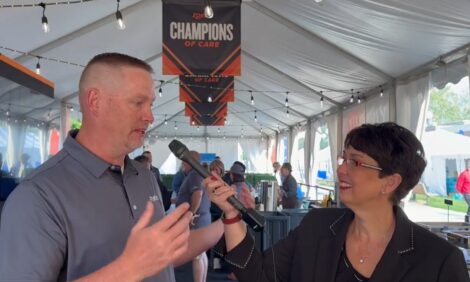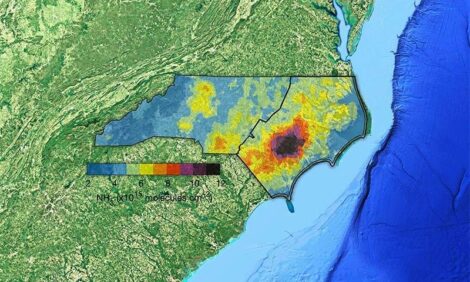



Effects of Feeding and Housing Systems for Gestating Sows and Gilts
A summary by Cynthia Niemann, MU Swine Production student.Reproductive performance is critical to the profitability of a producer, along with the welfare of the animals involved. Because reproductive performance is negatively affected by stress, one could use measures of reproduction to illustrate the overall welfare of the animals involved in specific housing and feeding systems. The farrowing rate of sows can be influenced by the ability to show standing heat and the ability to maintain a pregnancy. If the herd is stressed, it will not have a high farrowing rate. In order to determine which combination of feeding and housing system is better for the producer and the animal, a study was conducted by investigators at Texas Tech University, at Lubbock City.
In the study a group containing 160 seven month old gilts was used to determine the effect of crated versus penned and drop-fed versus trickle-fed systems for gestating sows. The drop-fed systems allow the sow to obtain all of the nutrients needed for that day at a single moment, whereas the trickle-fed system forces the animal to feed over a 30 minute period. These 160 gilts were recorded for two parities. In the first parity, 117 farrowed, and in the second parity, 72 farrowed. All of the gilts came from the same farm and were bred through artificial insemination when standing estrus was shown. If the animal did not become pregnant, she was removed from the study, and therefore was not included for farrowing rate purposes.
The gilts were divided into four groups, each receiving a different treatment. The treatments included: drop-fed and crated, drop-fed and penned, trickle-fed and crated, and trickle-fed and penned. The gilts were randomly assigned to a treatment group to reduce the influence of extraneous differences. All of the housing units had slotted concrete flooring. The crates were 2' x 7', and pens were 10'7' so each provided 14 ft.2 of space per pig. In order to keep this space consistent between groups, filler sows were added, but not included in the study so that each group pen contained five pigs.
During the study, several of the major measures taken were those regarding sow productivity. Gilts and sows were transported to farrowing crates when they approached farrowing. Here they were allowed to eat a corn/soybean meal diet ad libitum for five to seven days following parturition. After weaning, they returned to their group-specific feeding program (either drop-fed or trickle-fed daily). Records of the number born alive along with the number born dead were kept for each sow. Each sow and her piglets were weighed at farrowing and weaning, usually 22 days postpartum.
The results on overall sow productivity were not great, but there were some differences noted. One of these differences involved the farrowing rates of the four treatment groups. Gilts housed in pens had an eleven percent lower farrowing rate than gilts housed in crates. Of the gilts in pens, there was a total of 89 farrowed, whereas the gilts in crates farrowed a total of 100, when both parities were added together. When housed in crates while being trickle-fed, gilts had seven to fifteen percent better farrowing rates than gilts housed in crates while being drop-fed. It is important to note that there was no significant difference when only the feeding system was considered.
Another measure of productivity used was backfat thickness. There was no difference seen at farrowing or breeding, but it increased twelve percent at weaning on sows that had been housed in gestation pens compared to those kept in group pens. Farrowing and weaning weights were also observed for the groups. While farrowing weights were lower for sows drop-fed and housed in crates than those of sows trickle-fed in crates, there was no real difference seen in the two groups of penned sows. There was an increase in piglet weaning weights when the sows were drop-fed instead of trickle-fed during gestation, although feeding treatments did not continue while the sows were in the farrowing facilities.
The occurrence of wounds or skin lesions was also measured during farrowing and weaning. These wounds were given a score of one through three, depending on the severity (one being mild and three being severe). This measurement was not particularly helpful in determining which treatment was better. The results showed low wound and lesion occurrence through all groups in the study.
Another area of concern was that of immunity. This was measured in a variety of ways including assays, RIAs, and phagocytosis assays. Several assays were performed on blood samples taken from the sows to determine immunity based on white blood cell count, chemokinesis, and chemotaxis among other things. RIAs were utilized specifically to measure plasma cortisol levels, which would help to evaluate the amount of stress the sows were under. However, the results from the RIAs were not unusual nor illustrated significant differences for any of the groups. Phagocytosis assays used isolated neutrophils to find the percentage of neutrophil phagocytosis. This measure was lower for trickle-fed penned sows and drop-fed crated sows than the drop-fed penned sows and trickle-fed crated sows. Therefore based solely on this measure drop-fed was better for sows kept in crates, but trickle-fed was better for those housed in pens. The measures of immunity were not particularly helpful in determining which treatment group was better for the sows and the producer because not many consistent differences were noticed.
The last measure observed in the sows was that of behavior during the two gestation periods. Here the researchers utilized time-lapse videos during a 24 hour period to observe the sows behavior and social interactions. The behaviors observed were drinking, eating, oral-nasal-facial behaviors, sitting, standing, and lying, along with the social behaviors of antagonistic, mounting, and non-aggressive interactions. There was no noticeable difference in the behaviors illustrated among the four treatment groups. However, there was a decrease in overall agonistic behaviors over the course of the study.
Behavior was also observed for a four hour period. Through this measure the oral-nasal-facial behaviors (ONF) and active behaviors were higher for drop-fed, crated sows than the other three treatment groups. In the trickle-fed pens, additional entering and exiting of the feeding stalls was seen during feeding when compared to drop-fed pens. However, this behavior subsided after feeding time had concluded. Overall there was no significant difference in the behaviors of the four treatment groups over the two parities.
When combining all of the conditions studied to determine which combination of feeding and housing systems were superior to the others, the outcome was inconclusive. Given the measures of productivity, occurrence of skin lesion and wounds, immune measures, and behavioral responses, there was no one system that was either better from the producers standpoint or for the welfare of the animal. It can be concluded that if any of the four treatments studied were managed correctly, the producer could do well while not affecting the welfare of the animals. Because cortisol levels were not elevated and there was no difference in immune response, one can gather that productivity and animal welfare are not greatly influenced by housing system or feeding system as long as good management is practiced.
A summary of "Evaluation of drop versus trickle-feeding systems for crated or group-penned gestating sows." by L. E. Hubert and J. J. McGlone, published in the Journal of Animal Sciences, volume 84, pg. 1004-1014.
January 2007







